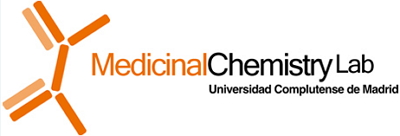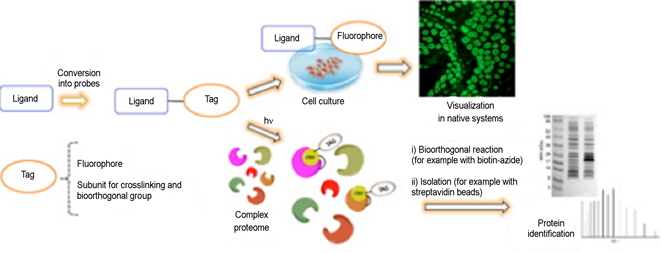CHEMICAL TOOLS FOR THE STUDY OF PROTEINS IN BIOLOGICAL SYSTEMS
|
Description |

Laboratory of Medical ChemistryUCM.
The Medicinal Chemistry Laboratory at the Universidad Complutense de Madrid (MedChemLab) develops research projects focused on the search of new therapeutic strategies for the identification of new effective treatments for high-incidence diseases. This objective is addressed through medicinal chemistry and chemical biology.
One of the most important current problems in the development of new drugs is the lack of new therapeutic targets. Toward the challenge of identifying new drug targets, we apply a combination of chemical biology and proteomic techniques that allow the study of complex biological systems in situ, revealing the profiles of protein expression and activity.
Thus, the technology developed in the research group is aimed at obtaining chemical probes based on the ligands of interest that allow the study of the target proteins in native systems (localization, expression levels, etc.). In addition, a platform based on mass spectrometry has been developed, which, together with the appropriate chemical probes, allows the identification of targets or the determination of de novo selectivity profiles of the ligands of interest.
|
How does it work |
Development of probes for the labeling of compounds.
The human proteome, formed by the total proteins present in humans, has the ultimate responsibility for the correct functioning of the organism as a whole. In this way, any alteration in the proteome activity, whether by default or by excess, leads to the appearance of pathologies.
Recent studies have shown the need for direct observation of the proteins that act as pharmacological targets under as much physiological conditions as possible. To this end, bioconjugation techniques (such as the use of the avidin-biotin or streptavidin-biotin pair), modular and orthogonal chemistry (Staudinger ligation, [3+2] cycloadditions) and the use of fluorophores have been developed.
Therefore, we apply all these techniques to obtain probes based on the ligand of interest with different functionalities (fluorescence labeling, affinity or cross-linking) in order to obtain global information that would be impossible to infer by traditional methodologies.
Development of a platform for de novo analysis of ligand selectivity using mass spectrometry.
Traditionally the selectivity profiles of the compounds are analyzed considering structural similarity, and an active compound in a receptor is systematically evaluated in the rest of subtypes of the same family. The main limitation of this methodology is that a prior knowledge of structural similarity is needed. However, recent studies show that proteins with a high degree of structural similarity may have different functions in vivo and, conversely, structurally different proteins can play similar functions and act by similar mechanisms. Additionally, similarities in primary structures do not necessarily correlate with similarities in tertiary structures that are responsible for ligand recognition. Thus, the need for a methodology that reveals the complete de novo selectivity profile of a compound is clear. In this context, the methodology developed in the research group allows to analyze the de novo selectivity profile of a compound in a complex proteome, using mass spectrometry techniques.
|
Advantages |
The competitive advantage that this technology developed in the Medicinal Chemistry Laboratory would afford to a company is the access to a methodology capable of establishing new de novo selectivity profiles and identifying new therapeutic targets.

Laboratory of Medical Chemistry UCM.
|
Where has it been developed |
The present work is developed in the Medicinal Chemistry Laboratory (MedChemLab) located in the Organic Chemistry Department of the Chemistry Faculty at the Universidad Complutense de Madrid. The research team is led by the full professor María Luz López Rodríguez and formed by the associate professors Bellinda Benhamú Salama and Silvia Ortega Gutiérrez, the assistant professors Mar Martín-Fontecha Corrales and Angeles Canales Mayordomo, two postdoctoral researchers, four graduate students, two master students, two undergraduate students, two Erasmus students, and a technician. The group includes researchers with different areas of specialization (organic chemistry, medicinal chemistry, nuclear magnetic resonance, biochemistry, cellular and structural biology, and molecular modeling).
The laboratory has all the equipment and instrumentation of a modern organic chemistry and chemical biology laboratory, necessary to carry out all the experiments of the different medicinal chemistry programs in course. Automatized purification systems, microwave reactor, hydrogenation systems, polarimeter, infrared, ultraviolet and fluorescence spectrometers, and a high pressure liquid chromatography system coupled to mass spectrometry are available. We also have access to the different UCM research support centers (CAI) of nuclear magnetic resonance, proteomics, microanalysis, X-rays, electron microscopy, cytometry, etc.
The solid trajectory of the research group is reflected in the funding of 14 projects financed by public entities and private companies (UCB Pharma, Italfarmaco, Vivia Biotech) in the last 10 years, as well as in its scientific productivity. During the last 5 years, 36 articles have been published in the most prestigious journals in the areas of medicinal chemistry and chemical biology (Nature, Nat. Commun., Nat. Neurosci., J. Natl. Cancer Inst., Angew. Chem. Int. Ed., J. Am. Chem. Soc., Allergy Clin. Immunol., Proc. Natl. Acad. Sci. USA, J. Neurosci., Chem. Commun., Oncotarget, Breast Cancer Res., Int. J. Cancer, Chem. Eur. J., J. Med. Chem., ACS Chem. Biol., J. Biol. Chem.), with an average impact factor of 10.82.
The most relevant contributions of the last 10 years are the contribution to the study of the G protein-coupled receptors (GPCRs), in particular the clinical phase progression of several 5-HT1A agonists in collaboration with SchwarzPharma and UCB Pharma (4 patents and 9 articles in J. Med. Chem.); The identification of a new type of cannabinoid receptor located in mitochondria (5 articles in Science, J. Neurosci., J. Biol. Chem., Nat. Neurosci. And Nature); The validation of the FASN and ICMT enzymes as new targets for the treatment of cancer (2 international patents and 7 articles in Clin. Cancer Res. Breast Cancer Res., J. Med. Chem., Int. J. Cancer and Oncotarget.) ; The validation of the MAGL enzyme in the treatment of multiple sclerosis (3 articles in Angew. Chem. Int. Ed., J. Med. Chem. and J. Neurosci.) and the development, together with Vivia Biotech, of a powerful allosteric modulator of the GLP1 receptor for the treatment of type diabetes 2 (two patents).
|
And also |
Partners are sought from public or private organizations related to the pharmaceutical industry and interested in the identification of therapeutic targets.
|
Contact |
|
© Office for the Transfer of Research Results – UCM |
|
PDF Downloads |
|
Classification |
|
Responsible Researchers |
Mª Luz López Rodríguez: mluzlr@quim.ucm.es
Silvia Ortega Gutiérrez: siortega@ucm.es
Department: Organic Chemistry (Laboratory of Medical Chemistry)
Faculty: Chemical Sciences


